
Archimedes is a large lunar impact crater on the eastern edges of the Mare Imbrium. Its diameter is 81 km.
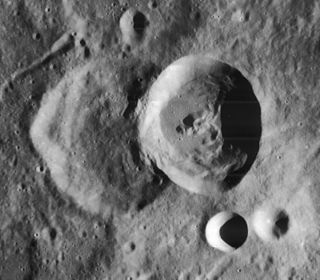
Sirsalis is a relatively young lunar impact crater located near the western lunar limb, to the southwest of the Oceanus Procellarum. The crater lies across a ridge that runs in a north–south direction. It has a sharp edge and a low central peak. The crater overlaps the slightly larger and older Sirsalis A to the west-southwest, and the two form a distinctive feature.

Wollaston is a relatively small lunar impact crater located in the Oceanus Procellarum. To the northwest is the similar Nielsen. To the southeast is the somewhat larger Krieger. There are several small rilles to the southwest of Wollaston, forming part of the Rimae Prinz.

Zupus is the lava-flooded remains of a lunar impact crater. It is located on a southwestern reach of the Oceanus Procellarum, to the northwest of Mare Humorum. To the north-northeast is the flooded crater Billy, and some distance to the southeast is Mersenius. A system of faint rilles named the Rimae Zupus lie to the northwest, following a course to the north-northwest towards the mare.
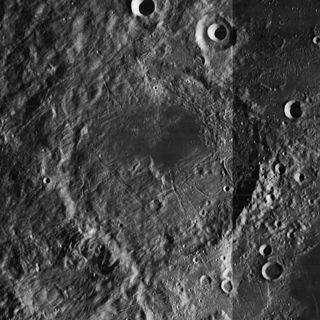
Riccioli is a lunar impact crater located near the western limb of the Moon. It lies just to the northwest of a larger crater, Grimaldi. To the southwest are the craters Hartwig and Schlüter that lie on the northeastern edge of Montes Cordillera, a ring-shaped range that surrounds Mare Orientale. Due to its location, Riccioli appears strongly foreshortened from the earth and is viewed almost from the side.

Hevelius is a low-rimmed lunar impact crater that lies at the western edge of the Oceanus Procellarum, named after the astronomer Johannes Hevelius. The smaller but prominent crater Cavalerius is joined to the northern rim by low ridges. Due south of Hevelius is the crater Lohrmann and the dark-hued Grimaldi.

Cavalerius is a prominent lunar impact crater that lies on the western edge of the Oceanus Procellarum lunar mare on the west part of the visible Moon. It nearly joins the northern rim of Hevelius to the south.
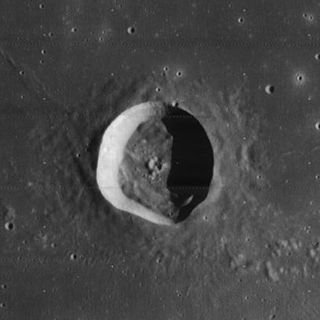
Flamsteed is a small lunar impact crater located on the Oceanus Procellarum, which is named after British astronomer John Flamsteed. It lies almost due east of the dark-hued Grimaldi, and north-northwest of the flooded Letronne bay on the south edge of the mare.

Kepler is a lunar impact crater that lies between the Oceanus Procellarum to the west and Mare Insularum in the east. To the southeast is the crater Encke. Kepler is named for the 17th century German astronomer and mathematician Johannes Kepler.

Prinz is the lava-flooded remains of a lunar impact crater on the Oceanus Procellarum. It was named after German-Belgian astronomer Wilhelm Prinz. The formation lies to the southwest of the prominent crater Aristarchus. To the north-northeast is the flooded crater Krieger.

Olbers is a lunar impact crater that lies at the west edge of the Oceanus Procellarum, near the western limb of the Moon. It lies to the northwest of the crater Hevelius, and to the north of the indistinct Hedin. Farther to the south is the crater Riccioli. Due to its location, this crater appears very oblong because of foreshortening. It is viewed nearly edge-on, making observation of the interior difficult from the Earth.

Balboa is a lunar impact crater that is located near the western limb of the Moon. Due to foreshortening, the crater appears highly oval when viewed from the Earth. In actuality, however, the formation is relatively circular. It is comparable in size to the crater Dalton, located just to the southwest. The eastern rim of Balboa lies just to the west of the Oceanus Procellarum.
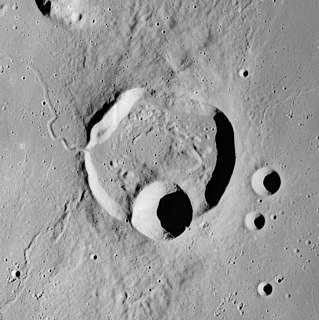
Krieger is a lunar impact crater on the eastern part of the Oceanus Procellarum. It is located to the north-northwest of the flooded crater Prinz, and north-northeast of the prominent ray crater Aristarchus. To the northwest lies the small Wollaston.
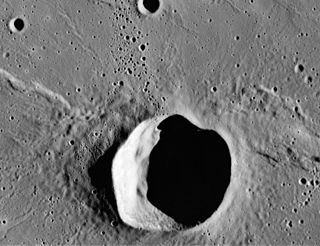
Herigonius is a small lunar impact crater that is located in the southern part of the Oceanus Procellarum, to the northeast of the crater Gassendi. It was named after French mathematician and astronomer Pierre Hérigone. Herigonius is roughly circular, with an inward bulge and narrower inner wall along the northeast. In the interior of the sloping inner walls is a floor about half the diameter of the crater.

Damoiseau is a lunar impact crater that is located just to the west of the Oceanus Procellarum, in the western part of the Moon's near side. It lies due east of the prominent crater Grimaldi, a walled plain with a distinctive dark floor. Due south of Damoiseau is the crater Sirsalis.

Darwin is a lunar impact crater of the type categorised as a walled plain. It lies in the southeastern part of the Moon, and is sufficiently close to the limb to appear significantly foreshortened when viewed from the Earth. Attached to its southern rim is Lamarck. To the northeast is the dark-floored crater Crüger.

Gerard is a lunar impact crater that lies along the western edge of the Oceanus Procellarum near the northwest limb of the Moon's near side. It is located to the north-northwest of the crater von Braun, and northeast of Bunsen. Because of its location, Gerard appears strongly foreshortened when viewed from the Earth, hindering observation.

Repsold is a lunar impact crater that is located at the western end of the Oceanus Procellarum. It lies to the northeast of the crater Galvani and southeast of the walled plain Volta. Due to its proximity to the northwestern limb of the Moon, this crater appears highly foreshortened when viewed from the Earth. It is named after Johann Georg Repsold, a German astronomer.
Fontana is a lunar impact crater that is located in the southwestern part of the Moon's near side, to the south of the Oceanus Procellarum. It lies to the west-northwest of the flooded crater Zupus. Midway between Fontana and Zupus is a rille system designated Rimae Zupus.





















